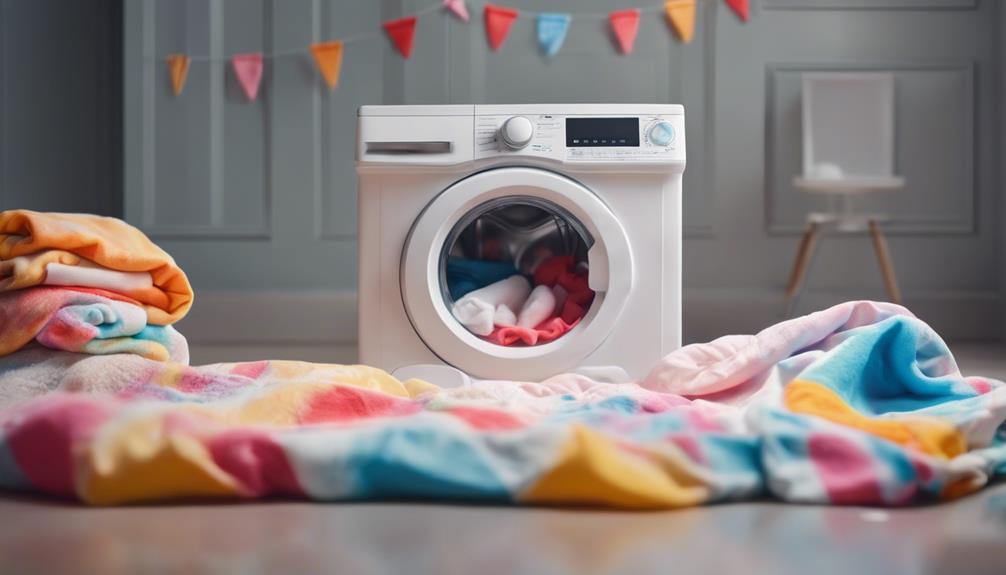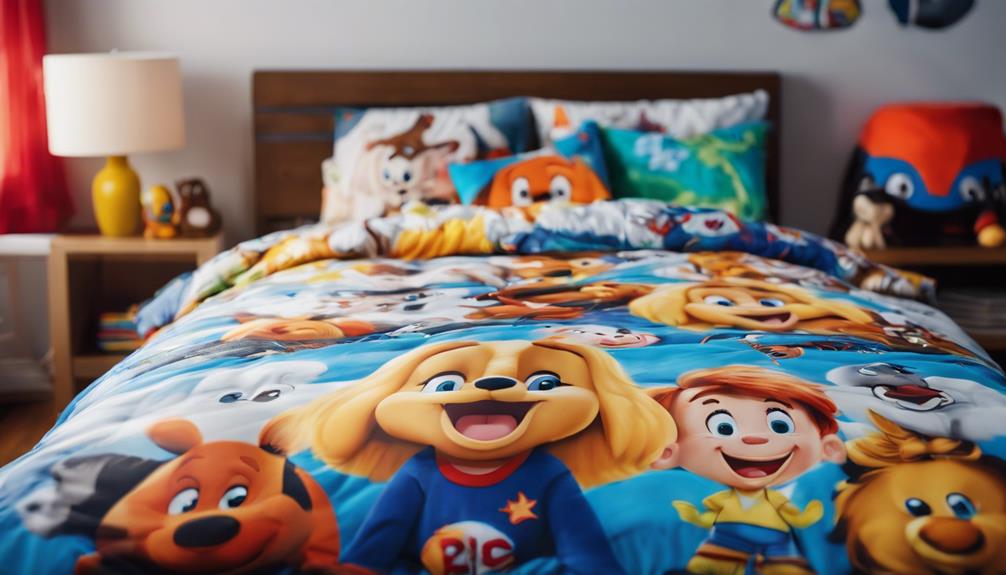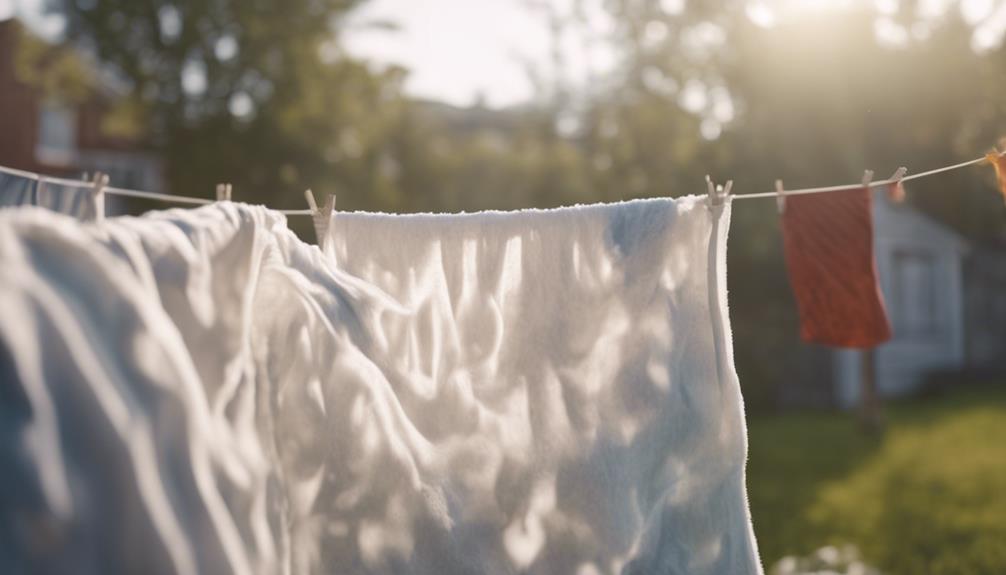Yes, a toddler can have a comforter for improved sleep quality. Ensure safety by using a toddler-specific size, approximately 40-by-60 inches, and opting for soft, breathable materials such as cotton or muslin. Look for signs that your child is ready, such as being able to regulate their body temperature and having self-soothing habits, before introducing the comforter. To maintain safety, avoid suffocation risks by ensuring a proper fit and using gentle materials. For a personal touch, consider adding colorful embroidery or unique patterns for additional comfort. Following these steps will create a cozy and secure sleep environment for your toddler. Further information on selecting and caring for comforters can enhance your child’s sleep experience.
Key Takeaways
- Introducing a comforter at age 2 enhances security and promotes better sleep habits.
- Select a toddler-sized comforter for safety and comfort.
- Ensure the child shows signs of readiness for a comforter.
- Choose appropriate materials like natural wool or muslin.
- Follow safety guidelines and proper maintenance for toddler comforters.
Comforter Safety Guidelines for 2-Year-Olds

When considering comforter safety guidelines for 2-year-olds, it's important to prioritize their well-being and comfort. A toddler can safely use a comforter, but caution is advised for infants under 12 months due to the risk of suffocation.
The size of a toddler comforter typically ranges from 40-by-60 inches, tailored to suit the average height and weight of a 2-year-old. Opting for toddler bedding is recommended as it provides a better fit and considers safety aspects.
Parents should be attentive to their child's preferences when arranging bedding, taking into account factors like entanglement risks and ensuring overall comfort. It's essential to consult a qualified physician for specific concerns regarding the safety of using a comforter for a 2-year-old.
Benefits of Introducing a Comforter at 2

Introducing a comforter at the age of 2 can greatly enhance a child's sense of security and comfort during sleep. Toddlers often find solace in having a familiar object, like a soft comforter, to cuddle with as they drift off to sleep. This sense of security can help them feel more at ease and settled, promoting a more restful night's sleep for both the toddler and the parents.
Having a comforter can also assist toddlers in learning to self-soothe. When they have their comforter nearby, they may feel more confident in soothing themselves back to sleep if they wake up during the night. This can lead to better sleep habits and a smoother bedtime routine overall.
Furthermore, a comforter can become a cherished object for a 2-year-old, providing comfort and familiarity in new or unfamiliar situations. This attachment to their comforter can help toddlers feel more secure and independent, encouraging them to stay in their own bed throughout the night.
Signs Your Child Is Ready for a Comforter

We can determine if a 2-year-old is ready for a comforter by observing their ability to regulate their body temperature effectively. Look for signs such as the child being able to push away or pull on bedding if they feel too warm or too cool.
If your little one shows a preference for using a blanket or stuffed animal for comfort, this may indicate readiness for a comforter. Keep an eye out for increased independence and self-soothing behaviors during sleep time, as these are important indicators that they might benefit from a comforter.
It's essential to pay attention to your child's safety and comfort when introducing a comforter at the age of 2. By noticing these signs and considering your child's behavior and needs, you can make a more informed decision about whether they're prepared for the comfort and security a comforter can provide.
Choosing the Right Size Comforter

To guarantee a comfortable and secure sleep environment for a 2-year-old, selecting the right size comforter is key. When choosing a comforter for your little one, consider the following:
- Measure the Crib or Toddler Bed: Assure the comforter fits the dimensions of the crib or toddler bed to prevent any potential safety hazards and to provide adequate coverage during sleep.
- Avoid Oversized Blankets: Opt for a comforter that's specifically designed for toddlers, with typical sizes ranging from 40-by-60 inches, as oversized blankets can pose suffocation risks.
- Select Soft and Safe Materials: Prioritize materials like natural wool or muslin that are gentle on your child's skin and provide comfort throughout the night.
- Consider Child's Preferences: Involve your little one in the selection process by choosing a comforter featuring their favorite characters or patterns to make bedtime more enjoyable.
Transitioning to a Toddler Comforter

Introducing a 2-year-old to a toddler comforter can encourage a sense of security and comfort during sleep. Moving to a toddler comforter aligns with safe sleep guidelines, making sure that the child is at an appropriate age to have such bedding. Toddler comforters, typically sized around 40-by-60 inches, are designed to meet the needs of a growing toddler. These comforters help toddlers develop attachment and self-soothe, positively contributing to their sleep routines. To aid in this change, it's crucial to choose a toddler comforter that is soft, hypoallergenic, and complements the child's bedding or room decor. Here is a table summarizing key points for shifting to a toddler comforter:
| Key Points | Details |
|---|---|
| Age Appropriateness | Ensure the child is at least 1 year old to safely introduce a toddler comforter. |
| Comforter Size | Opt for a toddler comforter around 40-by-60 inches to suit the average size of a 2-year-old. |
| Material and Design | Select a soft, hypoallergenic comforter that matches the child's bedding or room decor for added comfort. |
Establishing a Comforter Bedtime Routine

Establishing a consistent comforter bedtime routine can nurture a child's sense of security and promote restful sleep. Here are four key steps to help create a comforting bedtime routine with a toddler-sized comforter:
- Introduce the Comforter Early: Start incorporating the toddler-sized comforter into your child's bedtime routine early on to help them associate it with comfort and security.
- Create a Calming Ritual: Develop a calming bedtime ritual that involves cuddling with the comforter, such as reading a story or singing a lullaby, to signal to your child that it's time to wind down and prepare for sleep.
- Ensure Proper Fit for Safety: Choose a toddler-sized comforter that fits your child properly to prevent any risks associated with loose bedding and promote a safe sleeping environment.
- Monitor and Adjust: Keep an eye on your child during the initial stages of using the comforter to make sure they're comfortable and safe. Adjust the routine as needed to suit your child's preferences and promote a peaceful bedtime experience.
Comforter Vs. Blanket: Which Is Better?
When deciding on a comforter or blanket for a 2-year-old, it's crucial to take into account factors such as warmth, comfort, and safety.
Comforters offer more insulation and comfort due to their thicker design, creating a snug sleeping environment for toddlers. However, safety concerns, like suffocation risks, should also be factored in when choosing between a comforter and a blanket for a young child.
Age-Appropriate Comforter Options
Choosing between a comforter and a blanket for a 2-year-old involves considering factors like warmth, safety, and comfort. When deciding on the best option for your toddler, here are some key points to keep in mind:
- Safety First: Opt for a toddler comforter that's specifically designed for 2-year-olds to guarantee it meets safety standards.
- Comfort Matters: Look for a comforter that provides the right level of coziness without overheating your child.
- Security Blanket: Comforters can offer a sense of security and help toddlers self-soothe during bedtime.
- Enhanced Sleep: Introducing a toddler comforter can enhance your 2-year-old's sleep experience and promote a restful night.
Safety Concerns With Comforters
Toddler comforters offer a sense of security and promote better sleep for 2-year-olds compared to blankets. While comforters can be beneficial for toddlers, it's important to take safety concerns into account, especially for infants under 12 months.
Soft bedding, including comforters, should be kept away from babies under the age of one to reduce the risk of suffocation. When choosing a comforter for your toddler, opt for lightweight and breathable materials to guarantee comfort and safety during sleep. Materials like natural wool or muslin are recommended to prevent skin irritation and provide a cozy sleeping environment for your child.
Prioritize your child's safety by selecting a toddler comforter that's age-appropriate and safe for your little one's peaceful slumber.
Top Comforter Materials for Toddlers

We suggest contemplating natural wool and muslin as excellent materials for toddler comforters due to their softness and gentle feel on sensitive skin. When selecting a comforter for your little one, here are some top materials to contemplate:
- Natural Wool: Known for its warmth and hypoallergenic properties, wool is a great option for toddlers with allergies or sensitive skin.
- Muslin: Lightweight and breathable, muslin is soft to the touch and perfect for toddlers who tend to overheat during sleep.
- Cotton: A popular choice for toddler comforters, cotton is breathable, easy to clean, and gentle on delicate skin.
- Polyester: Durable and affordable, polyester comforters provide warmth and comfort, making them a practical choice for everyday use.
Remember to take into account any allergies your child may have when selecting the material for their comforter. By selecting the right material, you can ensure your toddler sleeps comfortably and safely.
Tips for Washing Toddler Comforters

To maintain the softness and quality of toddler comforters, it's important to follow proper washing guidelines. When washing toddler comforters, it's best to use a large capacity washing machine to guarantee thorough cleaning. Choose a gentle detergent suitable for delicate fabrics to prevent any damage to the comforter.
Opt for a gentle cycle with cold water to preserve the fabric's integrity and avoid potential shrinkage. It's vital to refrain from using bleach or fabric softeners when washing toddler comforters as these can impact the softness of the material.
After washing, either air dry the comforter or use a dryer on a low heat setting to prevent any potential shrinking or damage. By following these washing tips and using the right detergent, you can keep your toddler's comforter clean, soft, and in great condition for a long time.
Creative Ways to Personalize a Comforter

When personalizing a comforter for a 2-year-old, consider colorful embroidery options to add a special touch. Monogramming the child's name or initials can create a sense of uniqueness.
Opting for customized patterns and designs can make the comforter more appealing and engaging for the child.
Colorful Embroidery Options
Adding colorful embroidery to a toddler's comforter can provide a personalized and unique touch, enhancing the bedtime experience for your little one. When considering colorful embroidery options for your toddler's comforter, keep the following in mind:
- Customization: Choose names, initials, or fun designs that reflect your child's interests.
- Excitement: Personalized comforters with embroidery can make bedtime more engaging for your toddler.
- Visual Appeal: Opt for bright and colorful embroidery threads to enhance the visual appeal of the comforter.
- Meaningful Keepsake: The embroidery on a comforter can serve as a cherished keepsake as your child grows older.
Monogramming for Uniqueness
Monogramming a comforter adds a touch of uniqueness by embroidering the child's initials or name on it. It can make the comforter easily identifiable and personalized. This customization allows for various font styles, colors, and placement options to suit the child's preferences. Monogramming can be a thoughtful gift idea for birthdays or special occasions, adding a special touch to the child's bedding. Additionally, it can help prevent mix-ups in shared living spaces or daycare settings, ensuring that the comforter is always returned to the right owner. Consider monogramming other bedding items like a sleep sack, crib bumpers, or a fitted sheet to create a cohesive and personalized sleep environment for the child.
| Item | Monogramming Options | Benefits |
|---|---|---|
| Sleep Sack | Name initials | Easily identifiable |
| Crib Bumpers | Colorful fonts | Personalized touch |
| Fitted Sheet | Customized placement | Prevents mix-ups |
Customized Patterns and Designs
To infuse a touch of individuality and creativity into a comforter, exploring customized patterns and designs can offer a delightful way to personalize bedding for a 2-year-old. Here are some ways to make a comforter truly unique:
- Themed Designs: Incorporate popular themes like panda bears, construction vehicles, or favorite characters to cater to the child's interests.
- Handmade Personalization: Create personalized comforters as thoughtful gifts from family members, adding a special touch to the bedding.
- Emotional Attachment: Children often form strong bonds with their special blankets, making customized comforters cherished items for 2-year-olds.
- Comfort and Security: Unique patterns not only provide warmth but also offer emotional comfort and security to toddlers during sleep.
Frequently Asked Questions
Can a 2 Year Old Sleep With a Comforter?
Yes, a 2-year-old can sleep with a comforter. It's safe if the comforter is age-appropriate and doesn't pose a suffocation risk.
Experts suggest avoiding soft objects for infants under 12 months due to safety concerns. Toddler comforters are designed for warmth and comfort during sleep.
A comforter can serve as an intermediary object for security and comfort. Choose a size and material that guarantee safety and comfort for your child.
What Bedding Is Safe for a 2 Year Old?
For a 2-year-old, safe bedding options include toddler-sized comforters and blankets. These should be free from choking hazards and kept lightweight to prevent overheating or suffocation risks.
Consider bedding with breathable materials like cotton for comfort and safety. It's important to regularly check bedding for wear and tear, ensuring a secure sleep environment for your child.
Remember to follow manufacturer guidelines for washing and maintenance to keep bedding clean and hygienic.
At What Age Can You Introduce a Comforter?
At around 2 years old, it's generally a suitable time to introduce a comforter to your child. This transitional object can offer comfort and security during bedtime.
As toddlers develop motor skills, they can safely interact with a comforter. Supervising their use of the comforter is essential to prevent any risks.
What Bedding to Use for a 2 Year Old?
When choosing bedding for a 2-year-old, consider using toddler bedding for safety and comfort. Opt for a toddler comforter, typically 40-by-60 inches, to suit their size. It's important to keep soft objects away from infants under 12 months but safe for a 2-year-old. Make sure the bedding doesn't pose an entanglement risk.
Crib and toddler bedding are similar in size and materials, making them interchangeable. Observing the child's preferences is key when setting up their bedding.
Can a 2-year-old safely sleep with a comforter?
Yes, safe sleeping for babies with comforters is possible for a 2-year-old. Make sure the comforter is lightweight and breathable to reduce the risk of suffocation. Avoid large or fluffy comforters and ensure they are securely tucked in around the mattress to prevent any hazards during sleep.
Conclusion
To sum up, introducing a comforter to a 2-year-old can provide a sense of security and comfort during sleep time. By following safety guidelines, choosing the right size and materials, and properly caring for the comforter, parents can help their child adapt smoothly to this new bedtime accessory.
With personalized touches and creative ideas, the comforter can become a beloved part of the bedtime routine for both child and parent.










